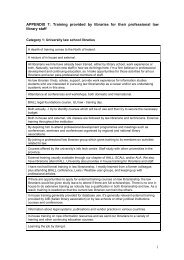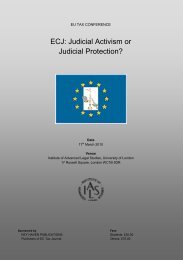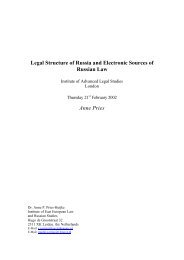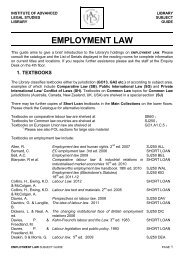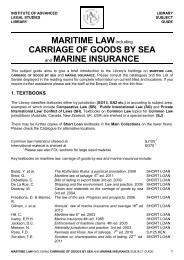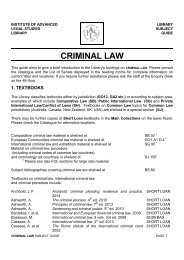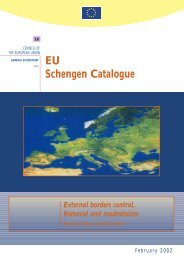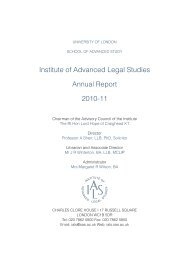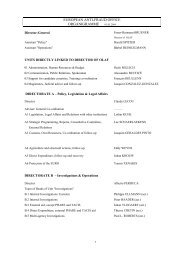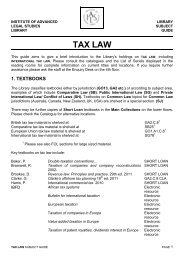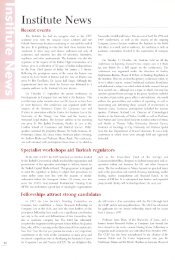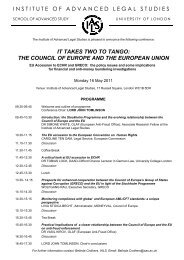a thesis - Institute of Advanced Legal Studies
a thesis - Institute of Advanced Legal Studies
a thesis - Institute of Advanced Legal Studies
You also want an ePaper? Increase the reach of your titles
YUMPU automatically turns print PDFs into web optimized ePapers that Google loves.
108 IMPLIED TRUSTS.<br />
court considers as involving him in the duties and responsibilities<br />
<strong>of</strong> a trustee, although but for such conduct or behaviour he would<br />
be a stranger to the trust. A constructive trust is therefore, as<br />
has been said, ' a trust to be made out by circumstances.' "<br />
The term, however, is used in a wider sense than is covered by<br />
this statement. There need be no trust "already constituted" at<br />
all. For instance, a vendor <strong>of</strong> land after contract, but before<br />
conveyance, is said to be a constructive trustee for the purchaser,<br />
as in Shaw v. Foster (1872, L. E. 5 H. L. C. 338), and other cases<br />
cited below. Again, if one <strong>of</strong> three partners entitled to a lease<br />
surrenders the old lease and takes a new one to himself, he is a<br />
constructive trustee for the others, as the case <strong>of</strong> Featllerstonhaugh<br />
v. Fenwick (1810, 17 Ves. 298) shows. Again, if a vendor executes<br />
a conveyance before he has received his purchase-money, the<br />
purchaser is a constructive trustee for him, as the leading case <strong>of</strong><br />
Mackreth v. Symmons (1808, 15 Yes. 329) shows, and so on. A<br />
constructive trust, as has been shown, is a species <strong>of</strong> trust created<br />
by implication or operation <strong>of</strong> law, being distinguished from the<br />
other sub-class <strong>of</strong> such trusts, namely, resulting trusts, by the<br />
characteristic <strong>of</strong> being independent <strong>of</strong> any intention <strong>of</strong> the parties.<br />
Constructive trusts arise in three classes <strong>of</strong> cases:—<br />
1. When a trustee or part owner <strong>of</strong> property gains an advantage<br />
from his position as such ;<br />
2. Agents employed by trustees become constructive trustees<br />
in certain cases; and<br />
3. Where the legal and beneficial interests in property are not<br />
combined in the same person.<br />
The leading illustration <strong>of</strong> constructive trusts <strong>of</strong> the first class<br />
is the case <strong>of</strong> Keech v. Sandford (1726, Select Ca. in Ch. 61),<br />
commonly known as the Eumford Market Case, in which Lord<br />
Chancellor King decided that a trustee <strong>of</strong> a lease who had renewed<br />
the lease in his own name and for his own benefit was a constructive<br />
trustee for his cestui que trust <strong>of</strong> the renewed lease, although<br />
there was no pro<strong>of</strong> <strong>of</strong> fraud and the lessor had declined to renew<br />
for the benefit <strong>of</strong> the cestui que trust. The Chancellor said that<br />
the trustee should rather have let it run out than have had the<br />
lease to himself. " This may seem hard, that the trustee is the<br />
only person <strong>of</strong> all mankind who might not have the lease; but it<br />
is very proper that rule should be strictly pursued, and not in the<br />
least relaxed ; for it is very obvious what would be the conse-



